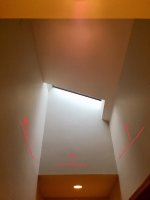ovrszd
Epic Contributor
- Joined
- May 27, 2006
- Messages
- 32,246
- Location
- Missouri
- Tractor
- Kubota M9540, Ford 3910FWD, Ford 555A, JD2210
Skylights are like holes in the bottom of a ship. You cannot do anything with them until they leak, then the best thing is to throw them away and put on a new roof.
I've never understood them. And I had never heard someone ask about how to insulate a column going to one. That's why I asked of it's R value.

